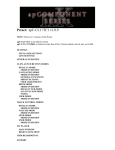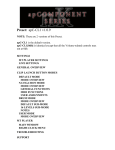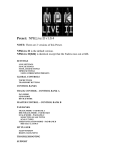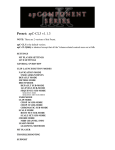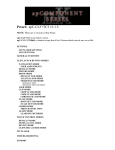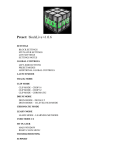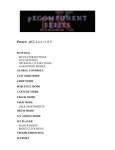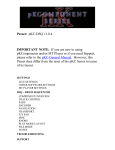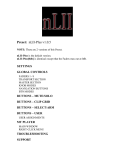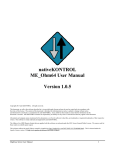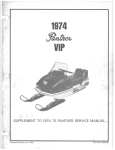Download nativeKONTROL omC-LiveA User Manual
Transcript
Preset: omC-LiveA v1.0.2 NOTE: There are 2 versions of this Preset. omC-LiveA is the default version. omC-LiveA[0db] is identical except that all the Volume-related controls max out at 0db. SETTINGS OHM64 SETTINGS MT PLAYER SETTINGS LIVE SETTINGS GLOBAL OVERVIEW TRACK CONTROLS TRACK CONTROL MODES DEVICE CONTROLS TRANSPORT CONTROLS BUTTON MODES CTRL MODE – NAV SUB-MODE USER ASSIGNMENTS CTRL MODE – FADER SUB-MODE DRUM MODE – DEF SUB-MODE DRUM MODE – 16 LVL SUB-MODE NOTES LAUNCH MODE – CLIP SUB-MODE LAUNCH MODE – TRACK SUB-MODE USER MODE – USR 1 SUB-MODE USER MODE – USR 2 SUB-MODE MT PLAYER MAIN WINDOW RIGHT-CLICK MENU TROUBLESHOOTING SUPPORT SETTINGS If you have trouble completing any of the settings listed here, please make sure to refer to the Troubleshooting section. OHM64 SETTINGS Every time you open an omC Series Preset, your Ohm64 will be restored to its factory settings. If you have a customized preset that you don't want to lose, please make sure to back it up BEFORE opening an omC Series Preset. MT PLAYER SETTINGS The first time you use the Ohm64 in MT Player, you may be prompted to setup the Ohm64’s ports. For both prompts, you should select your Ohm64. However, if you bypass those prompts, you can access the settings by rightclicking on MT Player and selecting MIDI Settings. 1. 2. 3. 4. 5. 6. From the Port Name menu, select “IN: Ohm64 Input”. From the MIDI In port menu, select your Ohm64 and click OK. Go back into MIDI Settings. From the Port Name menu, select “OUT: Ohm64 Output”. From the MIDI Out port menu, select your Ohm64 and click OK. Click the Restart button. You can learn more about MT Player in the MT Player section. NOTE: It is recommended that you launch MT Player, select a Preset and then launch Live. If Live is already running when you select or Restart a Preset, it is recommended that you enter, then exit MIDI mapping mode after selecting the Preset to re-initialize. LIVE SETTINGS The following settings will be found in Preferences on the MIDI/Sync tab. IMPORTANT NOTE: When you first install MT Player, Live will automatically turn on its Track switches. Before completing the steps below, turn off all the Track switches related to MT Player. 1 1. 2. 3. 4. Turn off all of the Ohm64’s Track/Remote/Sync switches. Deactivate the Track switches for From MT Player 2 and 3. Select MackieControl as a Control Surface. Select From MT Player 1 as the Input and To MT Player 1 as the Output. 5. Select MackieControl as a Control Surface. 6. Select From MT Player 2 as the Input and To MT Player 2 as the Output. 7. Select LV2_LX2_LC2_LD2 as a Control Surface. 8. Select From MT Player 3 as the Input and To MT Player 3 as the Output. 9. Select OHM40-DR as a Control Surface. This will be listed at the bottom of the Control Surface drop-down menu. 10. Select From MT Player 1 as the Input. 11. For Takeover Mode, select Pickup. 12. Activate the Track switch for From MT Player 1. 13. Activate the Remote switch for LV2_LX2_LC2_LD2 Input. 14. Activate the Remote switch for LV2_LX2_LC2_LD2 Output. 2 GLOBAL OVERVIEW TRACK CONTROLS The Ohm’s 8 Faders control Volume for the 8 Tracks in the current Bank. The bottom row of 8 Knobs control either Pan or Sends (as explained in the next section). The bottom 8 Buttons select Tracks 1-8 in the current Bank. These controls are collectively called Track Controls. Also, some of the Button Modes include Mute/Solo/Arm controls, which would also be included as Track Controls. You can move between Banks of Track Controls with Trk Bank down/up. NOTE: The Track Control Faders and Knobs include an internal Takeover feature (separate from Live’s Takover Mode), which eliminates parameter jumps when moving between Banks/Modes. If the Ohm’s physical controls differ from Live’s associated virtual controls, Takeover kicks in until the physical control meets the value of the virtual control. TRACK CONTROL MODES By default, the Track Controls will control regular Audio/MIDI tracks. They can also control the first 8 Return Tracks. The Return Bank can be selected/de-selected with Shift+Slct 8. By default, the Track Controls Knobs will control Pan for the 8 Tracks in the current Bank. Shift+Slct 6 will select Send Mode. In Send Mode, the 3 Track Control Knobs will control the first 8 Sends on the Selected Track. Shift+Slct 5 will re-select Pan Mode. DEVICE CONTROLS The top 8 Knobs control the selected Device. If the Device has more than 8 parameters, you can switch between Banks of 8 parameters with Device Bank down/up. TRANSPORT CONTROLS SHIFT – Shifts the function of other controls. Shifted functions are shown in Red in this manual and on all omC maps. PLAY – Start playback. B2A – Back to arrangement. STOP – Stop playback. STOP ALL CLIPS – Stop all playing clips. REC – Toggle Arrangement Record. CLIP REC – Use this to record perfectly cut Clips (Audio or MIDI) at the current Global Quantization value. For example, if Global Quantization is set to 2 bars, this will record a perfect 2-bar clip. This function is intended for the creation of new Clips, so Overdub should be turned off when using it. TRK BANK DOWN/UP– Move down/up a Bank of 8 Tracks. When moving between Banks, the first Track in the Bank will be selected. DEVICE BANK DOWN/UP– If the selected Device has more than 8 parameters, these will move down/up Banks of 8 parameters. UNDO/REDO – Undo/Redo. CROSSFADER – Controls Live’s crossfader. 4 BUTTON MODES This Preset provides 4 Buttons Modes that you can select via Shift+Slct 1-4. Each Button Mode includes 2 Sub-Modes. You can switch between these Sub-Modes with the Buttons to the left and right of the Crossfader. CTRL MODE – NAV SUB-MODE PLUS/PG UP – Plus/page up keystrokes. MINUS/PG DN – Minus/page down keystrokes. KEY UP/DOWN/LEFT/RIGHT – Arrow keystrokes. By holding down Shift, these can be used for multi-selections. ENTER/ESCAPE – Enter/escape keystrokes. LOAD CLIP – Load selected Clip(s) from browser onto selected Clip Slot(s). 5 FOCUS CONTROLS – These 3 controls move Live’s focus to different areas so that you can navigate/control them with keystrokes. MAIN FOCUS – Puts the focus on Live’s main window. FIX – Puts the focus back on the main element in Live’s main window. DETAIL FOCUS – Puts the focus on Clip View or Track View. BRWSR FOCUS – Puts the focus on Live’s Browser. SSN/ARNG – Toggle between Session and Arrange Views. CLIP/TRACK – Toggle between Clip and Track Views. BRWSR I/O – Show/hide the Browser. TGL BRWSR/PREV – Toggle to the next/previous browser in Live 8 (these buttons have no function in Live 9). This requires some additional setup as explained in User Assignments. MCU UP/DOWN/LEFT/RIGHT – These are multi-functional cursor Buttons. When in Session View, these will navigate. When in Arrange View, these with either navigate or zoom. The behavior is dictated by the Clip Launch button. CLIP LNCH – When in Session View, this will launch the currently selected Clip. When in Arrange View, this will toggle the behavior of the MCU cursor Buttons. When off, the cursor Buttons will navigate. When on, the cursor Buttons will zoom. SCN LNCH – In Session View, this will launch the currently selected Scene. BPM UP/DOWN – Increase/decrease Tempo by 1-BPM. USER 1 – 8 – These Buttons are User Assignable to Live menu functions. Each Button can be assigned a Default function and a Shifted function. Please see User Assignments. MUTE/SOLO/ARM 1-8 – These Buttons will Mute/Solo/Arm the 8 Tracks in the selected Bank. With the Mute and Solo Buttons, if you press them quickly, they will toggle. If you hold them down, they will function as momentary switches. 6 FADER MODE – Switch to Fader Sub-Mode. USER ASSIGNMENTS WINDOWS: In order to use Tgl Browser/Prev and/or User 1 – 8, you will need to download and install Live Menu Keys: http://beatwise.proboards.com/index.cgi?board=freesoft&action=display&thread=1131 Live Menu Keys will automatically configure Tgl Browser/Prev for you. To configure User 1 – 8, double-click the Live Menu Keys icon to open its configuration window and click the Add HotKey button. Press one of the User Buttons or Shift+one of the User Buttons to assign the HotKey. After the HotKey, you’ll list the menu item the HotKey should trigger. OS X: You can configure Tgl Browser/Prev and User Buttons 1 – 8 by using a utility built into the OS. To configure User Buttons 1 – 8, go to System Preferences – Keyboard & Mouse and click on the Keyboard Shortcuts tab. Scroll down to Application Keyboard Shortcuts and click the Plus button to add a new shortcut. The Application for all the shortcuts should be Live. Type the Menu Title exactly as it appears in Live’s menu. Assign the Keyboard Shortcut by pressing one of the User Buttons or Shift+one the User Buttons. To configure Tgl Browser/Prev, you will need to set up 6 additional shortcuts. The Keyboard Shortcut and Menu Titles are as follows: Ctrl+Alt+F1 = Live Devices Ctrl+Alt+F2 = Plug-In Devices Ctrl+Alt+F3 = Files 1 Ctrl+Alt+F4 = Files 2 Ctrl+Alt+F5 = Files 3 Ctrl+Alt+F6 = Hot-Swap NOTE: The names above are shown in English. If you are using a different language in Live, the names will be different. You can see these names by going to View – Browser. NOTE: For OS X users, once you’ve made all your assignments, you’ll need to close and restart Live for them to take effect. 7 CTRL MODE – FADER SUB-MODE In this Sub-Mode, each column of Buttons functions as a Fader for one of the 8 Tracks in the selected Bank. The Button LEDs indicate the current Volume setting and the Buttons can be pressed to set a new Volume level. Upon setting a new level, the current level will gradually be adapted to meet the new value. NOTE: If you use the Ohm’s Faders while in this Sub-Mode, the Button LEDs will update, but not until you stop adjusting the Faders momentarily. NAV MODE – Switch to Nav Sub-Mode. 8 DRUM MODE – DEF SUB-MODE NOTE: This Mode utilizes the concept of “Last Pad”, which is the last pad that was triggered. DRUM RACK – These 16 Buttons trigger the visible pads in Live’s Drum Rack. LAST PAD 1– This Button will trigger the Last Pad. This makes it so you have at least 2 Buttons to use to play fast rolls and such. This Button cannot be used while recording Cycle Sequences. 9 LOCK 1– This Button will lock Last Pad 1. This makes it so Last Pad 1 stays locked on the current pad. LAST PAD 2– Same as Last Pad 1. LOCK 2– Same as Lock 1. CYCLE 1 – This Button will play Cycle Sequence 1. On first press, it will output the first note in the sequence. On second press, it will output the second note in the sequence and so on. REC 1 – This will enable Record mode for Cycle Sequence 1. You can record up to 8 steps using the 16 Drum Rack Buttons. Press Cycle 1 to end recording. While recording, the 5th row of Buttons show how many steps you've recorded. This is replace-style recording so, if you exceed 8 steps, the previous 8 steps will be deleted. CYCLE 2 – Same as Cycle 1. REC 2 – Same as Rec 1. VELOCITY LEVEL – These 4 Buttons set the velocity level of the Drum Rack/Last Pad 1+2/Cycle 1+2 Buttons. The 4 available velocities (from top to bottom) are 127, 107, 87 and 67. MUTE/SOLO/ARM 1-8 – Same as described in the Ctrl Mode section. 16 LVL MODE – Switch to 16 Lvl Sub-Mode. 10 DRUM MODE – 16 LVL SUB-MODE DRUM RACK – Same as in Default Sub-Mode. 16 LEVELS – The Last Pad will be assigned to all 16 of these Buttons. VELO – Toggles 16 Levels of velocity. When on, the 16 Level Buttons will control the velocity of the Last Pad. PITCH – Toggles 16 Levels of pitch. When on, the 16 Level Buttons will control the pitch of the ALL Pads. 11 LOCK – This will lock the 16 Levels Buttons so that they stay locked on the current pad. MUTE/SOLO/ARM 1-8 – Same as described in the Ctrl Mode section. DEF MODE – Switch to Def Sub-Mode. NOTES The velocity functions described in the Drum Mode section will have no effect if the velocity sensitivity (Vel) is turned off (set to 0.0%) in the Simplers within your Drum Rack. Here’s an example of a compatible velocity setting: You can adjust the velocity setting for each Simpler in your Drum Rack or create a default preset that includes the velocity setting of your choosing. 12 LAUNCH MODE – CLIP SUB-MODE In this Sub-Mode, each Column of Buttons will launch the Clips in the first 8 Slots of Tracks 1-8. TRACK MODE – Switch to Track Sub-Mode. NOTE: By default, the Buttons will always Toggle Clips regardless of the Launch Mode in Live. If you’d like to use a different Launch Mode, you can MIDI map the Buttons to your Clips. NOTE 2: It is recommended that you Stop All Clips after loading your Sets. This is to ensure that everything is initialized correctly. 13 LAUNCH MODE – TRACK SUB-MODE LNCH 1-8 – These Buttons will Launch the currently selected Clip on Tracks 1-8. SCN LNCH – Launch the currently selected Scene. STOP 1-8 – These Buttons will Stop Tracks 1-8. XPOS UP/DOWN – Transpose the currently selected Clip Up/Down. XPOS RESET – Reset Transpose to 0 for the currently selected Clip. SCN UP/DOWN – Move Up/Down by 1 Scene. Shift+these Buttons will page Up/Down. MUTE/SOLO/ARM 1-8 – Same as described in the Ctrl Mode section. CLIP MODE – Switch to Clip Sub-Mode. 14 USER MODE – USR 1 SUB-MODE In this Sub-Mode, the first 40 Buttons are user-assignable via MIDI mapping mode in Live. MUTE/SOLO/ARM 1-8 – Same as described in the Ctrl Mode section. USR 2 MODE – Switch to Usr 2 Sub-Mode. NOTE: In order to avoid conflicts with this Preset’s controls, it is recommended that you set up any other controllers you might be using to operate on MIDI channels 9 – 16. 15 USER MODE – USR 2 SUB-MODE This Sub-Mode provides 8 sets of Inc/Dec Buttons that are user-assignable via MIDI mapping mode in Live. These are useful for controlling parameters that have less/more than 128 values. A couple of examples are Global Quantization and Clip Loop length. NOTE: When MIDI mapping the Inc/Dec Buttons, make sure that you are using the correct mapping Mode, which is Relative (Signed Bit). This information is shown on the Status Bar when you’re in MIDI mapping mode. MUTE/SOLO/ARM 1-8 – Same as described in the Ctrl Mode section. USR 1 MODE – Switch to Usr 1 Sub-Mode. 16 MT PLAYER MAIN WINDOW The drop-down menu in the center of the window is used for selecting Presets (if multiple Presets are available). The last selected Preset will be selected the next time you launch Player. The Restart button will restart a Preset and restore all of its default settings. The ? button will bring up the manual for the selected Preset. The IN and OUT indicators will light up to indicate MIDI activity. These are used for troubleshooting purposes. RIGHT-CLICK MENU MIDI Settings will bring up the MIDI Port Chooser window. Rescan MIDI devices will rescan MIDI devices on your system. This is useful in situations where your Ohm64 is not detected properly. Toggle Stats Display will show/hide event history. This is used for troubleshooting purposes. 17 TROUBLESHOOTING 1. Why don’t I see OHM64-DR listed under Live’s Control Surface dropdown menu? WINDOWS: On Windows, the OHM64-DR script will have gotten installed during install of omC. If it’s not showing up, please try reinstalling the omC II installer. No need to uninstall first. OS X: On OS X, you are prompted to manually transfer the script during install. If you skipped that step or need to retransfer the script for some other reason, you can find it along with transfer instructions in: (your name)/Bome’s Midi Translator/Player. 2. When I try to complete the MT Player Settings steps, I get an error message when I select the Ohm64’s ports. Please close Live, MT Player and any other MIDI applications. Then relaunch MT Player and you’ll be able to complete the settings steps. 3. Some of the button LEDs (like the Mute buttons for example) turn off when I press them. With older versions of the firmware, you’ll need to manually turn Local Control off. You can do that by pressing F1+M2 (the button underneath Fader 2) on your Ohm64. 4. In the demo video I saw from you, you were using some functions that I don’t have. Where are they? Presets evolve over time in regard to refinements and new functionality. In some cases, it’s necessary to reposition existing controls to make way for new functions. We try to keep rearrangements to a minimum and any rearrangements will always be covered in the Preset’s manual. 5. I have multiple copies of MT Player ports listed, which should I use? You should try to use the listings that start with “From” or “To”. For example, you shouldn’t use “3-From MT Player 1”, you should use “From MT Player 1”. In some cases, you will not have listings that start with “From” or “To”. 18 SUPPORT Email: [email protected] Forum: Beatwise Network Videos: Stray's YouTube Channel Copyright 2013-2014 nativeKONTROL. All rights reserved. This document, as well as the software described in it, is provided under license and may be used or copied only in accordance with the terms of this license. The content of this document is furnished for informational use only, is subject to change without notice, and should not be construed as a commitment by nativeKONTROL. Every effort has been made to ensure that the information in this document is accurate. nativeKONTROL assumes no responsibility or liability for any errors or inaccuracies that may appear in this document. All product and company names mentioned in this document, as well as the software it describes, are trademarks or registered trademarks of their respective owners. This software is solely endorsed and supported by nativeKONTROL 19




















